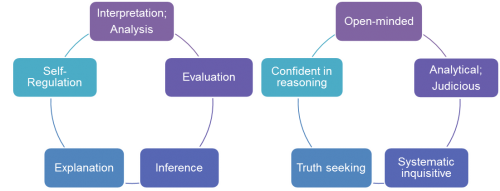The following entry from the 2012-2013 Teaching Issues Writing Consortium: Teaching Tips was contributed by Valerie Lopes, PhD, Professor, Centre for Academic Excellence, Seneca College, Canada.
————————————————————————————————————–
Critical Thinking:
A well-cultivated critical thinker:
- raises vital questions and problems, formulating them clearly and precisely;
- gathers and assesses relevant information, and effectively interprets it;
- comes to well-reasoned conclusions and solutions, testing them against relevant criteria and standards;
- thinks open-mindedly within alternative systems of thought, recognizing and assessing, as need be, their assumptions, implications, and practical consequences; and
- communicates effectively with others in figuring out solutions to complex problems.
- Critical thinking is, self-directed, self-disciplined, self-monitored, and self-corrective thinking. It entails effective communication and problem-solving abilities (Paul & Elder, 2002, p. 15).
Facione (2004) described cognitive skills and affective dispositions associated with critical thinking. These include:
Critical Thinking and the Learning Environment:
a. Formulate discussions and questions to improve adult learners’ critical thinking skills (Paul & Elder, 2006).:
- Clarity: Could you elaborate further? Could you give me an example?
- Accuracy: How could we find out if that is true? How could we verify or test that?
- Precision: Could you give me more details? Could you be more exact?
- Relevance: How does that relate to the problem? How does that help us with the issue?
- Depth: What factors make this a difficult problem? What are some of the complexities of this question?
- Breadth: Do we need to look at this from another perspective? Do we need to consider another point of view?
- Logic: Does all this make sense together? Does what you say follow from the evidence?
- Significance: Is this the central idea to focus on? Which of these facts are most important?
- Fairness: Do I have any vested interest in this issue? Am I sympathetically representing the viewpoints of others?
b. Plan authentic tasks which address important issues or problems.
c. Replicate real life situations within the discipline.
d. Restructure learning to promote higher level thinking (See “Blooms taxonomy”).
e. Promote active learning by planning inductive teaching- learning methods such as:
- Guided Inquiry;
- Problem-based;
- Project-based; and
- Case-base learning.
Resources: Svinicki & McKeachie, 2011; Huba & Freed, 2000; Paul & Elder, 2006; Prince & Felder, 2006.
Submitted by
Valerie Lopes, PhD
Seneca College, Canada
Professor, Centre for Academic Excellence

